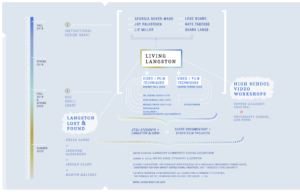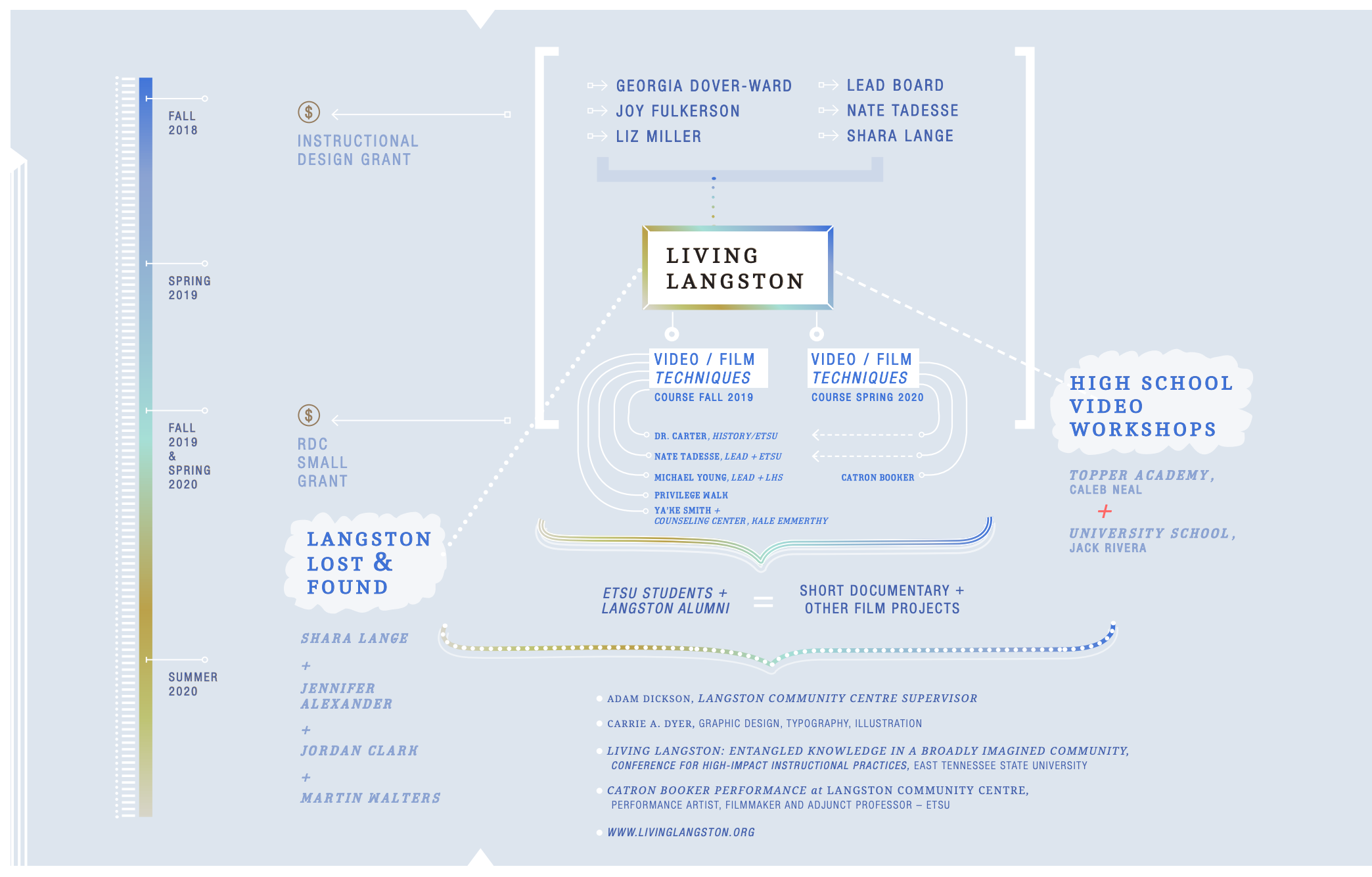 by Shara K. Lange
by Shara K. Lange
During the 2019/2020 academic year, I collaborated with community members and East Tennessee State University colleagues to assemble and enact a place-based network of classes, media project assignments, and relationships, Living Langston (livinglangston.org) that drew from diverse praxes and methodologies to record local African American history. The curriculum was developed from a media production request that came from an important institution in our community—the new Langston Community Centre, a cultural facility that promotes multicultural awareness and workforce development through arts, education and leadership activities. The project used the lens of African Americans’ experiences in a segregated high school to guide production students’ reflection about social justice and the implications of race on their own education.
Living Langston exemplifies EDIT 10’s best practice, NUMBER NINE: Know Your Resources. This is a project I could not have, and should not have, done on my own. Living Langston attempted to reconfigure power relationships in a traditional classroom through a network of collaborators, including community partners, student facilitators, guest speakers, and guest filmmaking instructors.
Joy Fulkerson (Leadership and Civic Engagement, ETSU) provided input early in the curriculum planning stages, facilitated a privilege walk for students in the course, and afterwards, co-presented a panel about the course at an East Tennessee State University Conference for High-Impact Instructional Practices. Dr. Daryl Carter, Professor of History, presented an overview of African American history to the students in my classes, emphasizing regional and education topics. Importantly, Living Langston, was designed specifically for students in Johnson City, Tennessee.
Langston High School was created for black students in the segregated south pre-1954, but after de-segregation, the facility sank into disrepair. A board of community members and Langston alumni worked for years to raise money to renovate what remained of the school. The renovated former gymnasium opened as a community arts center in fall 2019.
My students in two subsequent entry-level video production courses learned how to produce short videos through telling stories about former Langston High School students. As a white professor engaging students in telling stories about local African American history, it was especially important to provide historical context and diverse voices apart from my own to prepare students to work responsibly in the community.
The underlying premise of Living Langston is that media making, although not free from ethical pitfalls, involves meaningful processes that also function as profound, engaged forms of media literacy. Media making can function as, “sites at which users convene and engage with each other,” in order to create, “a conceptual space that responds to a key issue, a social movement, or a critical moment in time.” (O’Flynn, Making Publics: Web 2.0 Documentaries and Social Activism, 2011)
In other words, when students made documentaries about Langston High School alumni, narrative films based on alienating experiences that black students experienced in the American school system, or personal film essays about their own education, they had embodied experiences listening to other people, reflecting on other people’s lived experiences, and considering racism in ways they may not have before.
Examining their own education validates students’ experiences as a source of knowledge and insight that can be built upon while listening to the experiences of others. As bell hooks writes:
All students, not just those from marginalized groups, seem more eager to enter energetically into classroom discussion when they perceive it as pertaining directly to them (when non-white students talk in class only when they feel connected via experience it is not aberrant behavior). Students may be well versed in a particular subject and yet be more inclined to speak confidently if that subject directly relates to their experience.” (87)
Although none of the various tactics used in this project are new, I think that the scale of collaboration, strategies used to leverage resources, and efforts to document the relational complexity might offer some new insight for people who want to implement EDIT 10’s best practice, NUMBER NINE: Know Your Resources.
The scope of the Living Langston project is best illustrated using a map that graphic designer Carrie Dyer and I created along with a booklet to represent the Living Langston curriculum. This booklet is part of what we passed back to the Langston Community Centre and other project collaborators and invites a new set of questions for this and future projects: What happens when we chart the interpersonal elements of a community project visually? What value is there in listing names? What does this form of documentation help remember about the collaborative process and what does it help us to see?
Works Cited
hooks, bell. (1994). Teaching to Transgress: Education as the Practice of Freedom. New York: Routledge.
O’Flynn, S. (2011). Making Publics: Web 2.0 Documentaries and Social Activism. i-Docs Symposium. Bristol: Academia.edu.
Shara K. Lange is a filmmaker, Associate Professor, and Radio/Television/Film Program Head at East Tennessee State University in the Department of Media & Communication. Her documentary films have explored the social, psychological, and economic impacts of cultural collision in Marseille, Tangier, the Czech Republic and East Tennessee. Her work has been broadcast on PBS, screened at film festivals, and is distributed by Documentary Educational Resources and Third World Newsreel.


